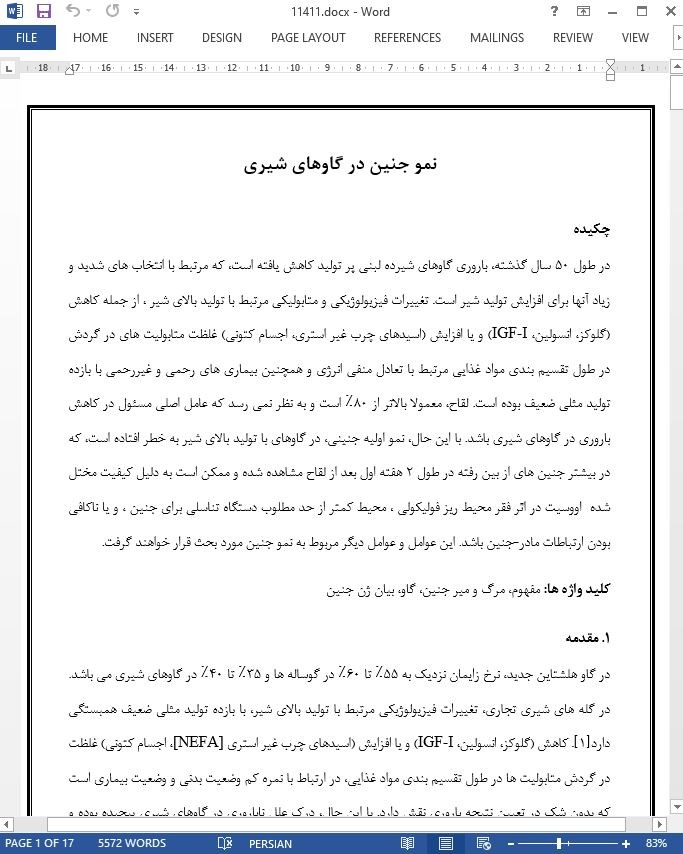
نمو جنین در گاوهای شیری
چکیده
در طول 50 سال گذشته، باروری گاوهای شیرده لبنی پر تولید کاهش یافته است، که مرتبط با انتخاب های شدید و زیاد آنها برای افزایش تولید شیر است. تغییرات فیزیولوژیکی و متابولیکی مرتبط با تولید بالای شیر ، از جمله کاهش (گلوکز، انسولین، IGF-I) و یا افزایش (اسیدهای چرب غیر استری، اجسام کتونی) غلظت متابولیت های در گردش در طول تقسیم بندی مواد غذایی مرتبط با تعادل منفی انرژی و همچنین بیماری های رحمی و غیررحمی با بازده تولید مثلی ضعیف بوده است. لقاح، معمولا بالاتر از 80٪ است و به نظر نمی رسد که عامل اصلی مسئول در کاهش باروری در گاوهای شیری باشد. با این حال، نمو اولیه جنینی، در گاوهای با تولید بالای شیر به خطر افتاده است، که در بیشتر جنین های از بین رفته در طول 2 هفته اول بعد از لقاح مشاهده شده و ممکن است به دلیل کیفیت مختل شده اووسیت در اثر فقر محیط ریز فولیکولی ، محیط کمتر از حد مطلوب دستگاه تناسلی برای جنین ، و یا ناکافی بودن ارتباطات مادر-جنین باشد. این عوامل و عوامل دیگر مربوط به نمو جنین مورد بحث قرار خواهند گرفت.
1. مقدمه
در گاو هلشتاین جدید، نرخ زایمان نزدیک به 55٪ تا 60٪ در گوساله ها و 35٪ تا 40٪ در گاوهای شیری می باشد. در گله های شیری تجاری، تغییرات فیزیولوژیکی مرتبط با تولید بالای شیر، با بازده تولید مثلی ضعیف همبستگی دارد[1]. کاهش (گلوکز، انسولین، IGF-I) و یا افزایش (اسیدهای چرب غیر استری [NEFA]، اجسام کتونی) غلظت در گردش متابولیت ها در طول تقسیم بندی مواد غذایی، در ارتباط با نمره کم وضعیت بدنی و وضعیت بیماری است که بدون شک در تعیین نتیجه باروری نقش دارد. با این حال، درک علل ناباروری در گاوهای شیری پیچیده بوده و ممکن است به اثراتی در نقاط متعدد در امتداد محور نموی جنین از جمله نمو فولیکول ها که بر کیفیت تخمک تاثیر می گذارد، محیط کمتر از حد مطلوب دستگاه تناسلی که قادر به حمایت از نمو طبیعی جنین نمی باشد و یا ترکیبی از هر دو نسبت داده شود [2].
5- نتیجه گیری
باروری ضعیف یک مسئله چند عاملی است که پیامد تعدادی از نقص ها در نقاط مختلف در طول محور نمو است. شواهد، حاکی از دخالت اووسیت، جنین، و دستگاه تناسلی در باروری ضعیف است. درک بهتر از زیست شناسی تکاملی که در نمو جنین و پذیرش رحم در گاوها دخالت دارد، ممکن است برای توسعه استراتژی هایی جهت به حداقل رساندن تلفات جنینی و بهبود بهره وری تولید مثل در گاوها کمک کننده باشد.
Abstract
During the past 50 years, the fertility of high-producing lactating dairy cows has decreased, associated with intensive selection for increased milk production. The physiological and metabolic changes associated with high milk production, including decreased (glucose, insulin, IGF-I) or increased (nonesterified fatty acids, ketone bodies) concentrations of circulating metabolites during nutrient partitioning associated with negative energy balance as well as uterine and nonuterine diseases have been linked with poor reproductive efficiency. Fertilization is typically above 80% and does not seem to be the principal factor responsible for the low fertility in dairy cows. However, early embryonic development is compromised in high-producing dairy cows, as observed by most embryonic losses occurring during the first 2 weeks after fertilization and may be linked to compromised oocyte quality due to a poor follicular microenvironment, suboptimal reproductive tract environment for the embryo, and/or inadequate maternal–embryonic communication. These and other factors related to embryo development will be discussed.
1. Introduction
In the modern Holstein, calving rates are close to 55% to 60% in heifers and 35% to 40% in lactating dairy cows. The physiological changes associated with high milk production have been linked with poor reproductive efficiency in commercial dairy herds [1]. Decreased (glucose, insulin, IGF-I) or increased (nonesterified fatty acids [NEFA], ketone bodies) concentrations of circulating metabolites during nutrient partitioning associated with low body condition score and disease status undoubtedly play a role in determining reproductive outcome. However, understanding the causes of infertility in dairy cattle is complex and may be attributable to impacts at numerous points along the developmental axis including compromised follicle development impacting on oocyte quality, a suboptimal reproductive tract environment incapable of supporting normal embryo development, or a combination of both [2].
5. Conclusion
Subfertility is a multifactorial issue resulting as a consequence of insults at various points along the developmental axis. Evidence exists implicating the oocyte, the embryo, and the reproductive tract in subfertility. Improved understanding of the developmental biology involved in conceptus development and uterine receptivity in cattle may contribute for the development of strategies to minimize embryonic losses and improve reproductive efficiency in cattle.
چکیده
1. مقدمه
2- بارداری ضعیف، یک مسئله چندعاملی
1-2- فولیکول / تخمک
2-2- محیط دستگاه تناسلی
3. نمو جنینی در گاوهای شیری
4- عملکرد آندومتر در گاوهای شیری
1-4- اثرات ناشی از جنین بر آندومتر
5- نتیجه گیری
Abstract
1. Introduction
2. Subfertilityda multifactorial issue
2.1. Follicle/oocyte
2.2. Reproductive tract environment
3. Conceptus development in dairy cows
4. Endometrial function in dairy cows
4.1. Conceptus-induced effects on the endometrium
5. Conclusion
- اصل مقاله انگلیسی با فرمت ورد (word) با قابلیت ویرایش
- ترجمه فارسی مقاله با فرمت ورد (word) با قابلیت ویرایش، بدون آرم سایت ای ترجمه
- ترجمه فارسی مقاله با فرمت pdf، بدون آرم سایت ای ترجمه


